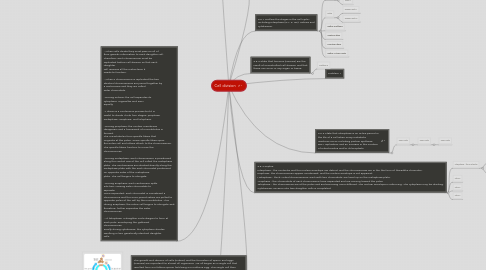
1. Mitosis process
2. The growth and division of cells (mitosis) and the formation of sperm and eggs (meiosis) are important for almost all organisms. We all began as a single cell that resulted from our father’s sperm fertilizing our mother’s egg. This single cell then divided by mitosis into two cells (daughter cells) which then grew and divided into four cells. This process of mitosis continued until we were born. It then continued again until we were “grown up”. It is still happening right now as some of our cells use mitosis to replace old dead cells, such as skin cells.
2.1. New node
3. - When cells divide they must pass on all of their genetic information to each daughter cell. Therefore, each chromosome must be replicated before cell division so that each daughter cell receives all the instructions it needs to function. - When a chromosome is replicated the two identical chromosomes are joined together by a centromere and they are called sister chromatids. - During mitosis, the cell separates its cytoplasm, organelles and DNA equally. - Mitosis is a continuous process but it is useful to divide it into four stages: prophase, metaphase, anaphase, and telophase. - During prophase, the nuclear membrane disappears and a framework of microtubules is formed. The microtubules form spindle fibers that originate at the poles. Some spindle fibers span the entire cell and others attach to the chromosomes. The spindle fibers function to move the chromosomes. - During metaphase, each chromosome is positioned along the central axis of the cell called the metaphase plate. The centromeres are situated directly along the metaphase plate with the each chromatid positioned on opposite sides of the metaphase plate. The cell begins to elongate. - During anaphase, each centromere splits into two, causing sister chromatids to separate. Once separated, each chromatid is considered a chromosome and the once-joined sisters are pulled to opposite poles of the cell by the microtubules. Also during anaphase, the entire cell begins to elongate and, therefore, further separates the sister chromosomes. - At telophase, a daughter nuclei begins to form at each pole, enveloping the gathered chromosomes. Finally during cytokinesis, the cytoplasm divides resulting in two genetically identical daughter cells.
4. 2.5.6 State that growth, embryonic development, tissue repair and asexual reproduction involve mitosis.
4.1. Growth
4.2. Embryonic Development
4.2.1. The zygote undergoes rapid mitotic divisions with no significant growth and cellular differentiation, leading to development of an embryo.
4.2.2. Position the three embryonic germ layers, the endoderm, ectoderm and mesoderm. These layers later develop into certain bodily systems.
4.2.3. The ectoderm develops into the skin, nails, the epithelium of the nose, mouth and anal canal; the lens of the eye, the retina and the nervous system.
4.2.4. The endoderm develops into the inner linings of the digestive tract, as well as the linings of the respiratory passages. It also forms many glands, such as the liver and pancreas.
4.2.5. Give rise to the muscles, circulatory and excretory systems of the body.
4.3. TIssue repair
4.3.1. Adult skin consists of two tissue layers: a keratinized stratified epidermis and an underlying thick layer of collagen-rich dermal connective tissue providing support. Hairs and glands are derived from, and linked to, the epidermis but project deep into the dermal layer.If a tissue is damaged or a cell is dead; mitosis regulates the cell division producing the new cells
4.3.1.1. New node
4.4. Asexual reproduction
4.4.1. Making of a new organism without the fusion of a sperm and egg. Without sex.
4.4.2. Only one parent.
4.4.3. All offspring are identical to the parent.
4.4.4. Making of new and more of body cells. Skin cells making new skin cells. Muscle cells making new muscle cells.
4.4.5. New node
5. 2.5.5 Explain how mitosis produces two genetically identical nuclei.
6. Problem 1
7. 2.5.1 Outline the stages in the cell cycle, including interphase (G1, S, G2), mitosis and cytokinesis.
7.1. Goals
7.1.1. Goal 1
7.1.2. Goal 2
7.2. Rules
7.2.1. Session Rule 1
7.2.2. Session Rule 2
7.3. Define Problems
7.4. Capture Ideas
7.5. Prioritize Ideas
7.6. Define Action Points
8. 2.5.2 State that tumours (cancers) are the result of uncontrolled cell division and that these can occur in any organ or tissue.
8.1. Problem 2
9. 2.5.4 Sophie Interphase - the nucleolus and the nuclear envelope are distinct and the chromosomes are in the the form of threadlike chromatin. Prophase- the chromosomes appear condensed, and the nuclear envelope is not apparent. Metaphase - thick, coiled chromosomes, each with two chromatids, are lined up on the metaphase plate. Anaphase - the Chromatids of each chromosome have separated and are moving toward the poles Telophase - the chromosmes are at the poles and are becoming more diffused. The nuclear envelope is reforming. The cytoplasm may be dividing. Cytokinesis- Division into two daughter cells is completed
9.1. Interphase - the nucleolus
9.1.1. Sub Idea 1
9.1.2. Sub Idea 2
9.2. Idea 2
9.3. Idea 3
9.4. Idea 4
10. 2.5.3 State that interphase is an active period in the life of a cell when many metabolic reactions occur, including protein synthesis, DNA replication and an increase in the number of mitochondria and/or chloroplasts.
10.1. New node
10.1.1. New node
10.1.1.1. New node
